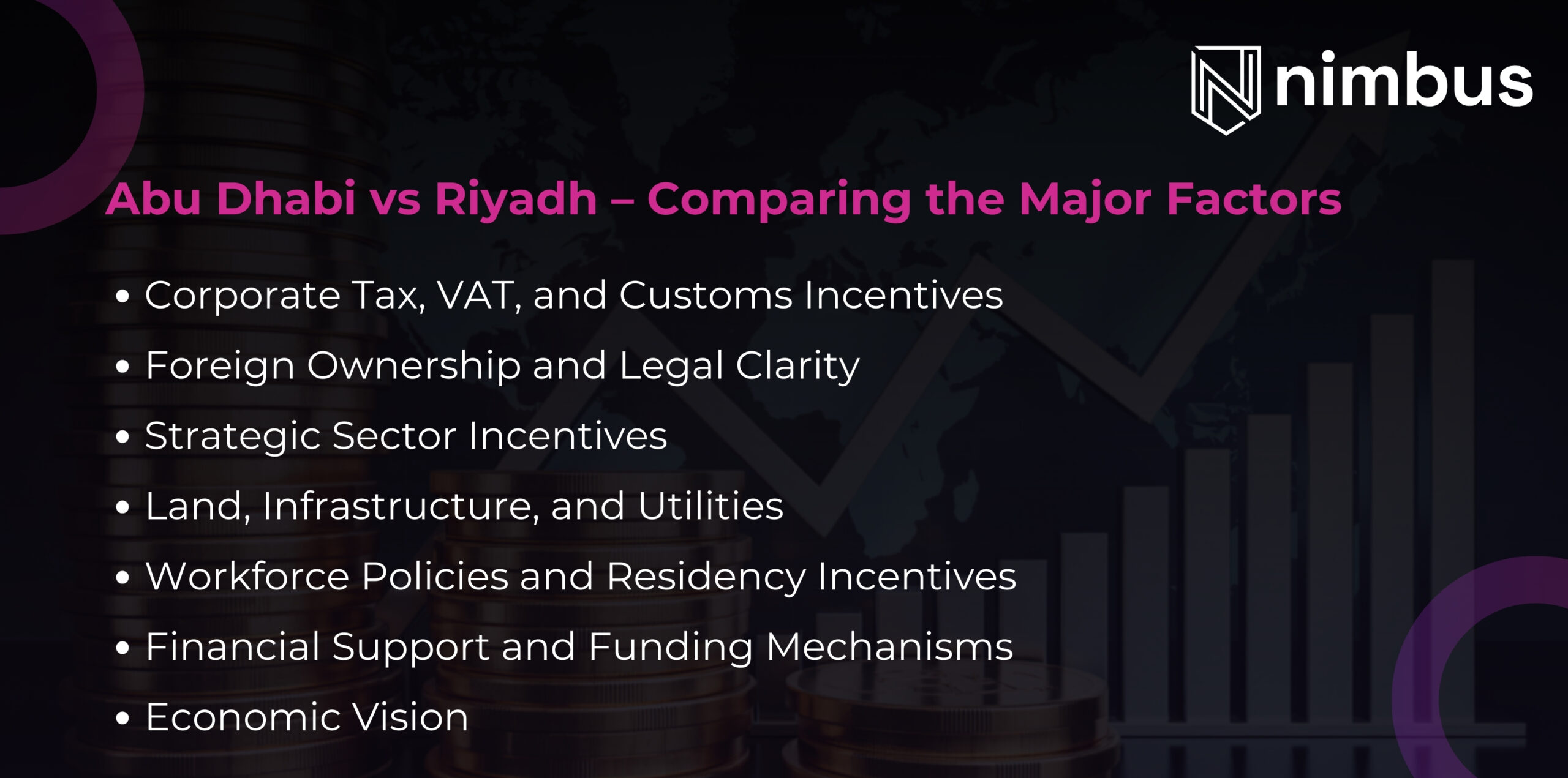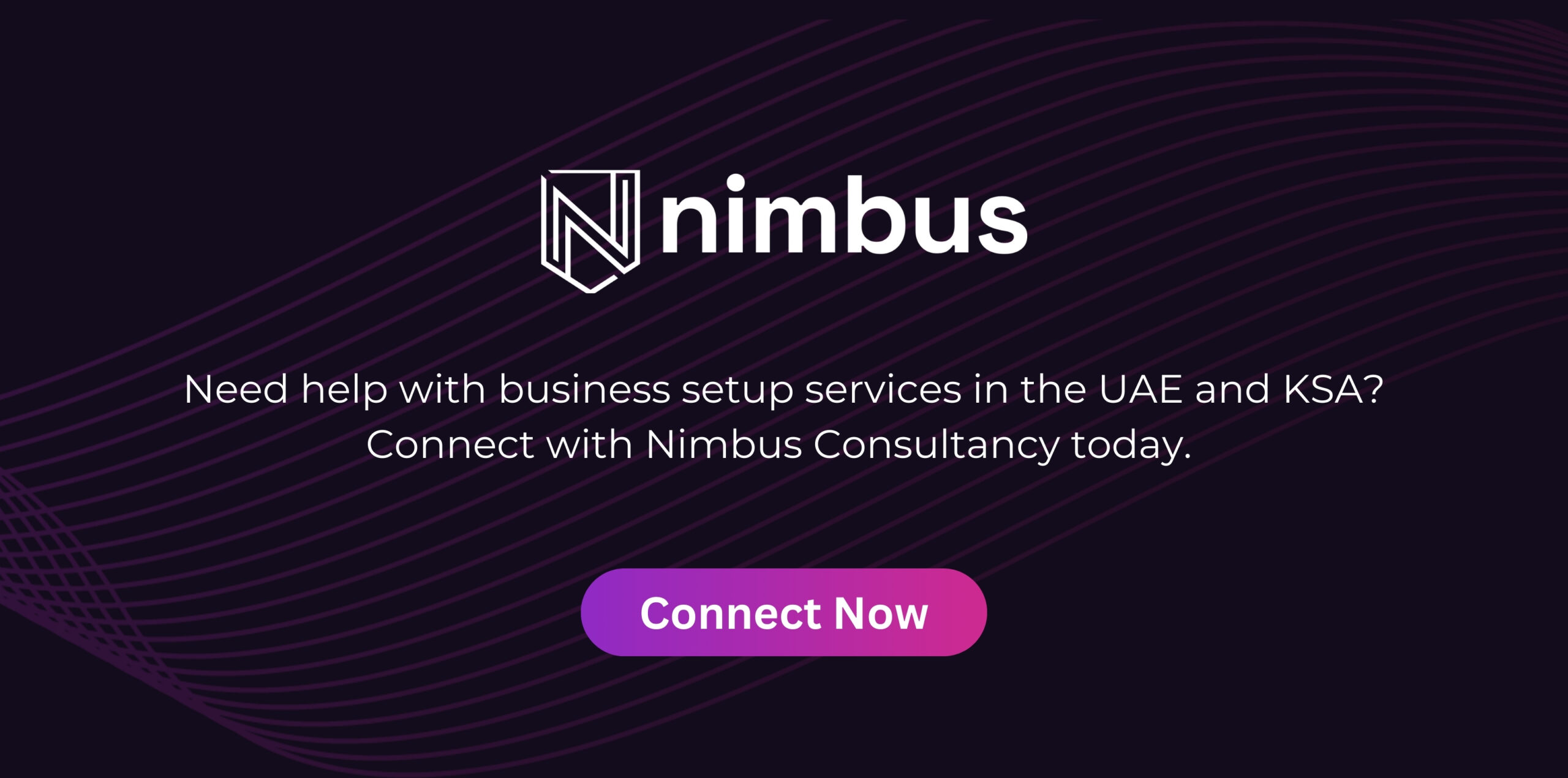Foreign direct investment (FDI) has become the cornerstone of economic diversification in the Gulf regions. Abu Dhabi and Riyadh, two of the region’s power centers and hubs for business setup in the UAE and KSA respectively, are now locked in a high-stakes competition to attract global capital with their sharply contrasting FDI models.
While Abu Dhabi builds on free zones, industrial support, and innovation incentives, Riyadh leans into Special Economic Zones (SEZs) and mega-projects, all tied to its Vision 2030 blueprint.
The goal for both: become magnets for international business, secure technology transfers, create skilled jobs, and anchor global companies in the region. But how do these models compare?
Here’s a look across the major factors including tax regimes, sectoral focus, and the overall regulatory environment.
Abu Dhabi vs Riyadh – Comparing the Major Factors

1. Corporate Tax, VAT, and Customs Incentives
Abu Dhabi
- Offers 0 percent corporate income tax for qualifying companies in free zones, provided they meet the requirements.
- Mainland tax is set at 9 percent on profits above AED 375,000 (US$102,110), with small businesses below that threshold exempt.
- VAT is 5 percent, but designated free zones are outside the VAT system, making intra-zone transactions VAT-exempt.
- Manufacturers get customs exemptions on industrial inputs and capital goods.
Riyadh
- SEZs offer a 5 percent corporate tax rate for up to 20 years, compared to the 20 percent standard rate outside the zones.
- Companies setting up regional headquarters can secure a 30-year tax holiday with 0 percent corporate and withholding tax.
- SEZs enjoy 0 percent VAT on internal transactions and full customs exemptions or deferrals on capital goods and inputs.
Key Takeaway: Riyadh’s SEZ tax regime is among the most aggressive globally, while Abu Dhabi leans on a tried-and-tested low-tax model with a stable VAT framework.
2. Foreign Ownership and Legal Clarity
Abu Dhabi
- Permits 100 percent foreign ownership across 122 activities in 13 sectors such as renewable energy, manufacturing, ICT, and healthcare.
- Operates under a clear “positive list” system that defines eligible sectors, reducing investor ambiguity.
- Legal and regulatory systems are well-established, with company formation costs cut to AED 1,000.
Riyadh
- SEZs allow full foreign ownership without local partner requirements.
- Certain SEZs, such as NEOM, operate under autonomous legal frameworks with their own tax and civil laws, modeled on international norms.
- Eased talent hiring rules apply during early operational years.
Key Takeaway: Abu Dhabi scores high on regulatory clarity and legal maturity, while Riyadh offers flexible ownership under a more experimental but bold framework.
3. Strategic Sector Incentives
Abu Dhabi
- Focused on advanced manufacturing, Industry 4.0, and the circular economy through its AED 10 billion Industrial Strategy (ADIS).
- The Abu Dhabi Investment Office (ADIO) runs an AED 2 billion Innovation Program, funding startups in ICT, health tech, biopharma, and agritech.
- Over AED 1.3 billion already allocated to 40+ firms since 2020.
Riyadh
- NEOM and other SEZs focus on high-growth sectors like biotech, clean energy, AI, and logistics.
- NEOM aims to contribute US$48 billion to GDP by 2030 and generate 380,000 jobs.
- The Standard Incentives Program covers up to 35 percent of eligible investment, capped at SAR 50 million.
Key Takeaway: Abu Dhabi is investing heavily in innovation-driven sectors, while Riyadh is chasing scale through bold bets on mega-sectors and infrastructure-heavy zones.
4. Land, Infrastructure, and Utilities
Abu Dhabi
- The Land Rebate Incentive Program (LRIP) offers discounted long-term leases for companies in priority sectors.
- Energy Tariff Incentive Program (ETIP 2.0) provides steep electricity and gas discounts based on performance scores—firms scoring over 80 get the highest tier.
Riyadh
- Industrial lands are leased for up to 30 years under the Authorized Economic Operator program.
- Residential land is made available around SEZs to support workforce relocation.
- NEOM markets itself as a 100 percent renewable-powered city, offering sustainable energy solutions.
Key Takeaway: Both regions offer competitive land and energy incentives, but Riyadh’s bundling of residential support signals a more integrated city-zone approach.
5. Workforce Policies and Residency Incentives
Abu Dhabi
- The Golden Visa offers 10-year residency to investors contributing at least AED 2 million, covering family and key staff.
- Emiratization requires companies with 50+ employees to increase local hires by 2 percent yearly to qualify for government-linked benefits.
- In-Country Value (ICV) certification is tied to meeting these workforce quotas.
Riyadh
- SEZ firms are permanently exempt from Saudization quotas.
- The Premium Residency program offers flexible long-term residency options, but entry capital requirements often exceed SAR 500,000.
- Companies hiring Saudis gain access to additional support from the Human Resources Development Fund.
Key Takeaway: Abu Dhabi uses targeted workforce nationalization policies tied to industrial incentives. Riyadh offers investors more labor flexibility, especially in early-stage ventures.
6. Financial Support and Funding Mechanisms
Abu Dhabi
- The Smart Manufacturing Incentive Program dedicates AED 500 million (US$136 million) to help SMEs digitize and modernize operations.
- The Golden List Program supports local suppliers through preferential government procurement.
- Innovation grants from ADIO have exceeded AED 1.3 billion.
Riyadh
- The Saudi Industrial Development Fund (SIDF) can finance up to 75 percent of a project with repayment terms up to 20 years.
- The Standard Incentives Program provides grants of up to SAR 50 million or 35 percent of investment value.
Key Takeaway: Abu Dhabi focuses on digitization and supplier support. Riyadh offers bigger funding volumes with longer repayment cycles, favoring large-scale industrial projects.
7. Economic Vision
Abu Dhabi
- Home to world-class infrastructure in aviation, ports, and logistics.
- Programs are aligned with the UAE’s push for innovation-led, export-driven growth.
Riyadh
- The US$800 billion Riyadh expansion project aims to make it a global business hub with access to 2 billion consumers.
- NEOM alone is projected to contribute US$100 billion annually to GDP by 2030.
Key Takeaway: Abu Dhabi is building on logistics and innovation connectivity. Riyadh is chasing a mega-city future with scale-driven ambitions.
What’s Your Pick?
Abu Dhabi and Riyadh represent two sides of the Gulf’s evolving investment playbook, especially in company formation in the KSA and UAE.
Abu Dhabi is crafting an innovation-first hub that favors policy clarity and targeted sector growth through its free zones and industrial strategy. Riyadh, meanwhile, is positioning itself as an economic powerhouse through large-scale SEZs and urban mega-projects like NEOM.
For investors looking for business setup services in GCC regions, the choice may come down to business model and risk appetite. Those seeking regulatory certainty and gradual growth may find Abu Dhabi the safer bet.
Those chasing big-ticket incentives and first-mover advantages in emerging markets may be drawn to Riyadh’s bold strategies.
So what’s it going to be for you?



